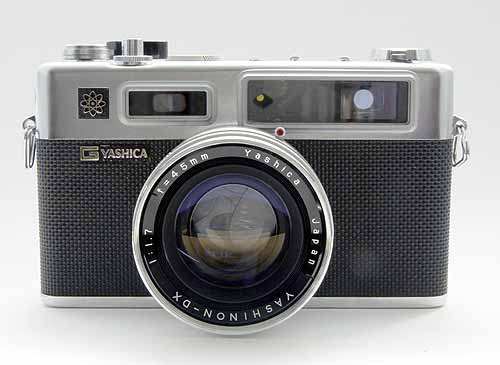I own a Neolithic predecessor to today’s compact digicams, a Yashica GS 35mm rangefinder camera from the early 70s. It was, in its day, a cheap but good Japanese alternative to the seminal Leica M4. But because the quality of film stock, processing, and printing are such crucial elements for a film image, even a cheap but good film camera, in the right hands, can produce photos almost as good as the most expensive gear. So as one modern user notes, the Yashica gives you “90% of the image quality [of a Leica M4] at less than 5% of the price.” I paid about $20 for mine and it still works almost as well as it did new.

A film camera is just a lightbox. Assuming the shutter mechanism is accurate, the quality of a film image (on the camera level) is determined simply by correct focus, correct exposure, and the quality of the lens.
Those first two variables, on cameras like the Yashica and Leica, are mostly left up to the user. As for the lens, the Yashica has a 45mm f1.7 Yashinon that is much faster than even the fastest modern zoom, and surprisingly sharp. With good film and a capable user, the Yashica can indeed produce Leica-caliber photos.
In contrast, modern digital cameras are separated much more in image quality by engineering, components and, consequently, price. Unlike days past, you now have to pay for image quality mostly on the front end, in your digital camera purchase, rather than mostly on the back end, in film and processing.
Don't think for a second that this is a bad thing. The economics of digital are great. Really great. Photography has never been cheaper. But skimping on your camera purchase, or making a bad camera choice, can really only be remedied by buying another camera. Informed buying has never been so important for photographers of all levels.
But it is an unfortunate fact that while my $20 Yashica can produce Leica-caliber photographs, a compact digicam takes nothing like the quality of photographs that DSLR and DSLR-class prosumer cameras do. And most digi-compacts can’t touch my Yashica, either, at least when it is in capable hands. In fact, some modern compacts produce worse quality images than the models they replace.
Here’s why . . . (part 2)

A film camera is just a lightbox. Assuming the shutter mechanism is accurate, the quality of a film image (on the camera level) is determined simply by correct focus, correct exposure, and the quality of the lens.
Those first two variables, on cameras like the Yashica and Leica, are mostly left up to the user. As for the lens, the Yashica has a 45mm f1.7 Yashinon that is much faster than even the fastest modern zoom, and surprisingly sharp. With good film and a capable user, the Yashica can indeed produce Leica-caliber photos.
In contrast, modern digital cameras are separated much more in image quality by engineering, components and, consequently, price. Unlike days past, you now have to pay for image quality mostly on the front end, in your digital camera purchase, rather than mostly on the back end, in film and processing.
Don't think for a second that this is a bad thing. The economics of digital are great. Really great. Photography has never been cheaper. But skimping on your camera purchase, or making a bad camera choice, can really only be remedied by buying another camera. Informed buying has never been so important for photographers of all levels.
But it is an unfortunate fact that while my $20 Yashica can produce Leica-caliber photographs, a compact digicam takes nothing like the quality of photographs that DSLR and DSLR-class prosumer cameras do. And most digi-compacts can’t touch my Yashica, either, at least when it is in capable hands. In fact, some modern compacts produce worse quality images than the models they replace.
Here’s why . . . (part 2)
No comments:
Post a Comment